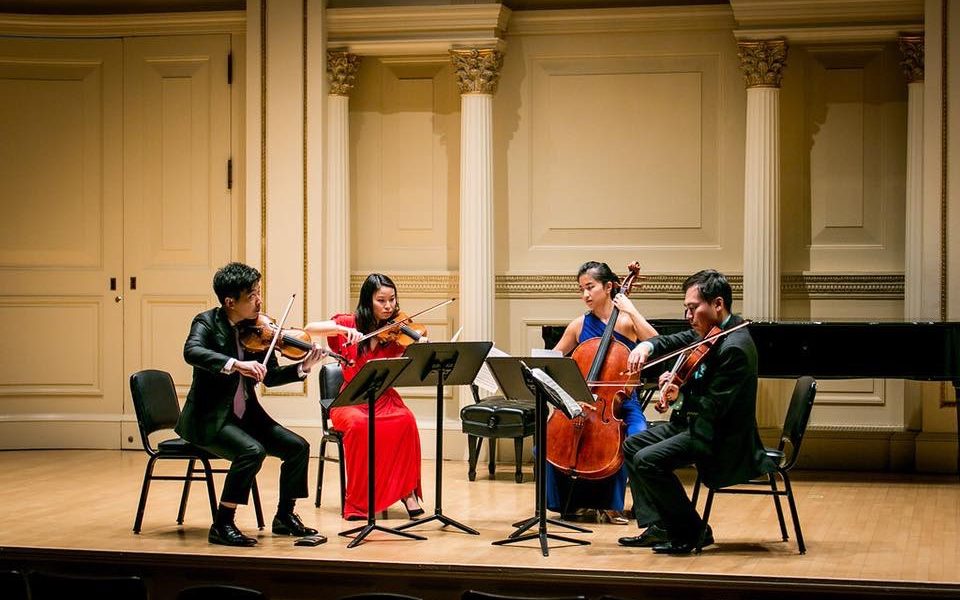New Asia Chamber Music Society presents New Asia Chamber Music Society with Zhang Fang, Piano in Review
Max Tan, William Wei, Ji In Yang; violin
Wei-Yang Andy Lin, viola
Nan-Cheng Chen, Grace Ho; cello
Zhou Yi, pipa
Zhang Fang, guest pianist
Weill Recital Hall at Carnegie Hall, New York, NY
November 20, 2017
The New Asia Chamber Music Society was founded in 2010 by a group of young Asian-American musicians who were graduates of prestigious American music schools, among them The Juilliard School and the Curtis Institute. Their mission statement says that they are “committed to bringing audiences exceptional performances of the chamber music repertoire drawn from the canon of western music as well as contemporary Asian culture.” This concert shows that they are certainly succeeding in their mission.
The concert began with a performance of Eight Drunken Immortals, a trio for piano, pipa (Chinese lute), and cello composed in 2013 by Dong-Qing Fang (b.1981). According to Wikipedia, “The Eight Immortals are a group of legendary xian (immortals) in Chinese mythology… Some drunken boxing styles make extensive use of the Eight Immortals archetypes for conditioning, qigong/meditation and combat training.” The composer chose six of these archetypes (drunken- intention, drinking, hitting, steps, playfulness, fists) and wrote a short “character piece, a la Robert Schumann” for each archetype. Each received a brilliant performance. Cellist Grace Ho drew a beautiful sound from her instrument during the lyrical passages, and she was equally compelling during the wilder movements. Pianist Zhang Fang was in constant synch with his colleagues, acting as a supportive accompanist when needed and exhibiting virtuosic skill when called for, but it was the playing of the pipa by Zhou Yi which made the deepest impression on this listener. We first heard rapidly repeated notes which reminded one of the mandolin. Using this technique, Ms. Zhou spun out finely shaped melodies. In one especially beautiful passage, a melody played by Ms. Zhou was repeated by the cello and then played by both performers. This melding of the east and the west was most beguiling. The pipa is capable of many sounds – harmonics and wonderful percussive effects. All were beautifully performed by Ms. Zhou.

From left to right: Max Tan, Ji In Yang, Zhang Fang, Nan-Cheng Chen, Wei-Yang Andy Lin
Photo by Ben Tso Photography
A work for solo piano, Poetry with Silent Mountain (2011), by Wantong Jiang (b.1957) followed. To be frank, I couldn’t quite understand what the program notes meant, other than the relaxed sounds we were to hear symbolized “the self-singing” of silence. Pianist Zhang Fang, who was most impressive in the rapid loud fast passages of the previous work, beautifully shaped the sounds and silences of this quasi impressionistic composition, producing wonderfully varied pianistic colors A recurring passage of low rumbling sounds in the piano’s lowest register followed by descending open fourths and fifths and concluding with louder octave passages gave the composition a discernable shape. Prepared piano sounds were created by pulling two “trussed horsetails,” one at the instrument’s lowest string at the beginning of the work, and one at the highest string at the conclusion.
The first half of the concert ended with a wonderful performance of Claude Debussy’s String Quartet in G Minor, Op. 10 (1893.) I am very happy to report that the fine ensemble playing we heard in tonight’s first work was heard both during the Debussy and the Brahms Piano Quintet heard after intermission. Each work was played with fine intonation, attention to detail and with the cohesiveness of an ensemble that had played together for a long time. The Debussy was performed by violinists William Wei and Ji In Yang, violist Wei-Yang Andy Lin, and cellist Grace Ho. Mr. Wei was a fine leader who played with energy and precision up to the very heights of the E-string. The other players weren’t “shrinking violets.” They perfectly balanced Mr. Wei and, when called for, spun out beautifully shaped melodies.

From left to right: William Wei, Ji In Yang, Grace Ho, Wei-Yang Andy Lin
Photo by Ben Tso Photography
The Brahms Piano Quintet in F minor, Op. 34 (1864), one of chamber music’s most monumental works, poses great musical and technical challenges for its five performers. Violinists Max Tang and Ji In Yang, violists Wei-Yang and Andy Lin, cellist Nan-Cheng, and pianist Zhang Fang, were up to the task. Readers of my reviews must know by now how I feel when performers do not obey the composer’s instructions to repeat a first movement’s exposition. They can imagine my joy when, for the first time while attending a live performance of this piece, I heard the beginning of the first ending and, after five measures, again heard the beginning of the exposition. I would like to publically offer my thanks to the performers for their bravery in doing the right thing. But, as the saying goes, “Beware of getting what you wish for.” It seemed to me that the tempo of the second playing of the exposition was a bit faster than the first. I ask the players to listen to the performance tape and, if I am incorrect, I will be the first to admit being in error. In any case, I am sure of the fact that there was a tendency to rush in movements two and three, especially during crescendi and loud passages, but these were just tiny blemishes on what was a thrilling performance.



